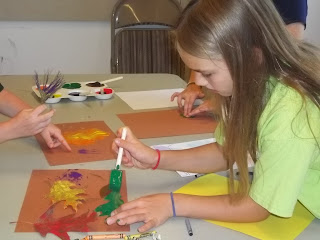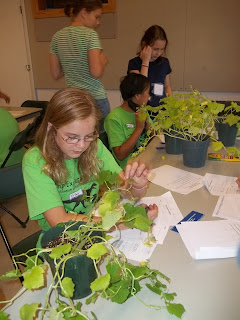We have had a great seventh week of camp! This week is Science Sampler where we learned about different sciences.
 |
| Playing with oobleck. |
Monday was all about messy science. We made
oobleck featured in Dr. Seuss's
Bartholomew and the Oobleck using cornstarch and water. Oobleck is a "Non-Newtonian" liquid which means it is a runny consistency when you let it move freely through your hands and a solid when you apply pressure to it.
 |
| Dry Ice Bubbles |
Another interesting experiment we did was dry ice bubbles. We were able to hold a solid bubble filled with fog in our hands! We also used various materials to create our own bubble wands and make gigantic bubbles.
 |
| Making our dry ice bubbles! |
 |
| Look at that giant bubble! |
 |
| Goggles demonstrating insect eyes |
Tuesday we learned about incredible insects. Using special insect
goggles and other various materials we were able to compare the anatomy
of an insect to ourselves. We discussed important adaptations that some
insects have such as camouflage and colored our own butterflies to hide
around the museum, and then we created an insect of our very own.
We
also played a game called "The Waggle Dance" in which some of us were
forager bees gathering nectar (scented paper flowers with sugar
attached) and the rest of us were worker bees taking care of the hive
then matching the scent of the flowers that the forager bees brought
back. This demonstrated the real roles of bees in the hive.
 |
| Smelling the flowers for its scent. |
 |
| He found the flower with sugar! |
 |
| Making your own insect. |
 |
| Look at that insect! |
 |
| Seeing how an insect see. |
 |
| Looking at the parts of a cell. |
On Wednesday, we talked about how our bodies work starting with
cells! We created a cell and learned how all of the different smaller
parts of the cell work in living things.
 |
| Making the lungs |
In order to demonstrate how our
lungs work, we created a model lung in which the straw represented our
wind pipe taking in air, the larger balloon at the bottom demonstrated
our diaphragm contracting, and the smaller balloon inside the cup
represented our lungs filling with air when these parts of the body work
together. We also checked our vitals such as our heartbeat and blood
pressure and discussed ways in which we can be healthy in our group!
 |
| The finished lung! |
 |
| Making the lung "breathe" |
 |
| Checking our vitals |
 |
| A Cloud in a Bottle |
Thursday was about weather. We created our own miniature water cycle
experiment using a bowl of water, some clear plastic wrap, and a coffee
mug to demonstrate all of the steps. We also made a cloud using a
plastic bottle with a small amount of rubbing alcohol. We pumped air
into the bottle using a tire pump, and when we removed the pin, the air
pressure dropped, and the water molecules clung together creating a
cloud. To continue the discussion of clouds, we also observed some
outside and journaled about the types and shapes of the clouds that we
saw.
Friday was all about Bats Around the World. Michelle from the Organization for Bat Conservation's Bat Zone brought some live bats to show us. She talked about the importance of bats and even helped us to debunk some bat myths. We talked about how some bats use echolocation to find their food. She had a special machine where we could hear the bat's echolocation.
 |
| Listening to the echolocation of the big brown bat. |
Then we played an echolocation game where we simulated the sonar method
of echolocation that a bat uses by playing a game where we used sounds
to locate our "food". The bat sent out a sound signal to find the other
players (the insects or food). We also made our own origami bats.






































































